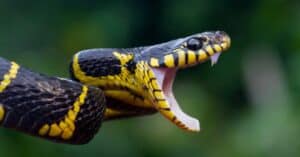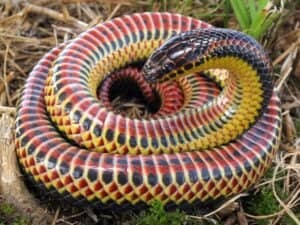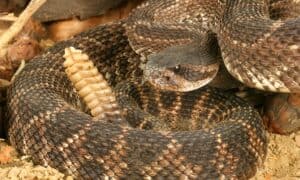10 Stunning Reptile Facts You Must Read!
From fearsome snakes to gentle tortoises, reptiles are a diverse and fascinating group of animals that have existed for hundreds of millions of years! Learning about our planet’s scaly inhabitants is always a treat, so I’ve put together a list of 10 of my favorite reptile facts that always manage to raise a few eyebrows when I share them.
Read on to learn some of the weirdest, creepiest, coolest, and overall most amazing facts about snakes, lizards, tortoises, crocodilians, and more.
1. The earliest reptile species lived over 300 million years ago.

iStock.com/Denja1
Historically, there’s been a lot of debate over what the first “true” reptile was and exactly when it first emerged from the Earth’s oceans. There are a handful of ancient animals that have been suggested, from the more amphibious Westlothiana to the poorly-documented Casineria.
The one species that archaeologists and other experts can agree on as the very first undeniable reptile, though, is none other than Hylonomus lyelli. It lived roughly 312 million years ago during the Late Carboniferous period, a time when amphibians were gradually making their transition onto land. Taxonomically, it belongs to the Sauropsida clade of “mammal-like” reptiles with “lizard faces.”
Fortunately, we have a fairly extensive fossil record for Hylonomus lyelli. Critically, this means we have a good idea of what it looked like and how it lived. The typical Hylonomus lyelli individual was likely around 8 to 10 inches long when fully grown, and it actually closely resembled most modern lizards of roughly the same size. It was probably an insectivore and fed on small insects and other invertebrates.
2. Some reptiles (mostly lizards) have a “third eye.”

Martin Pelanek/Shutterstock.com
Most lizard species actually have a very tiny, primitive third eye–better known as a parietal eye–that can sense changes in light overhead. Interestingly, many amphibians and even some bony fishes also possess this bizarre yet helpful trait.
To be clear, this “eye” is nowhere near as advanced as the typical lizard’s other two far more sensitive and biologically advanced eyes. On most lizards, the parietal eye is barely larger than the head of a pin, and it lacks the sensitivity and detail to perceive defined images and movement. Instead, it uses its own unique method to pick up on subtle changes in light and shadows. In addition, it works with the pineal gland to regulate hormone production.
While this doesn’t seem terribly impressive at first, the reptilian third eye is surprisingly helpful for thermoregulation and evading predators. It usually sits beneath a thin, protective translucent scale atop the lizard’s head between its true eyes.
3. The oldest living reptile on Earth is Jonathan, a 190-year-old tortoise.
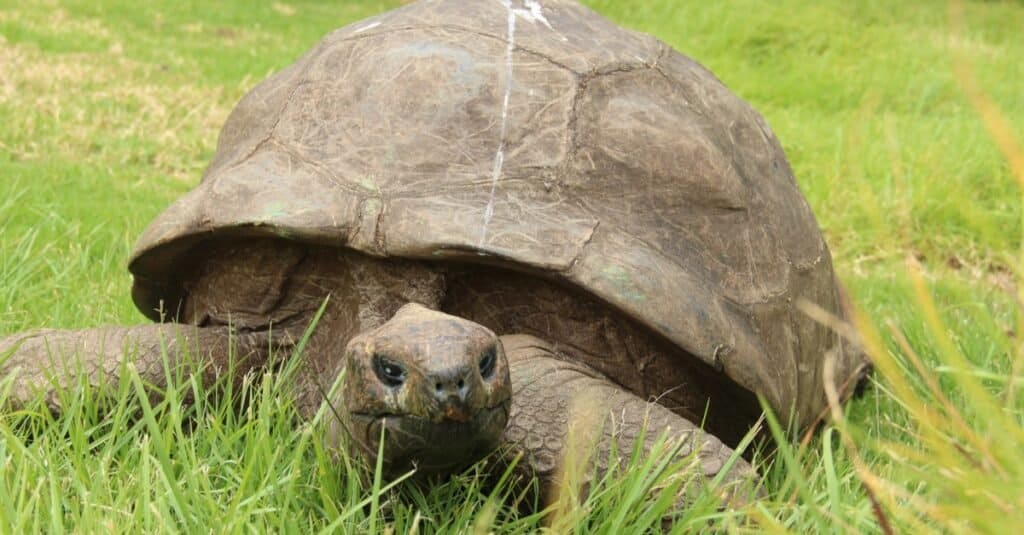
It’s no secret that tortoises have figured out the secret to living long, happy lives, but did you know that one of them is over 190 years old?
Incredibly, Jonathan the Seychelles giant tortoise hatched all the way back in 1832! Photographs of him exist from as far back as 1886, and in said photos, he was fully mature. This means he was already at least 50 years old in his oldest photo!
Jonathan has done a lot of traveling over the years, but today, he lives on a lavish, expansive plantation on the British island of Saint Helena. He doesn’t live there alone, though! By his side for more than 30 years is his companion, Frederica, another Seychelles giant tortoise with whom he spends much of his time eating, sleeping, and relaxing.
In more recent years, Jonathan has gone blind and lost much of his sense of smell. Other than that, he is remarkably healthy and active for his astonishingly old age!
4. One of the most ancient reptiles still alive today, the tuatara, is a “living fossil.”

One of the oldest and most perplexing reptiles still living today is the strange-looking and poorly understood tuatara. Although it looks a bit like a more primitive lizard, it is, in fact, part of its own distinct taxonomic order, Rhynchocephalia.
Notably, these ancient Rhynchocephalian reptiles evolved separately from lizards. They most likely originated around 250 million years ago during the Triassic period. Unfortunately, after the Jurassic period, most Rhynchocephalians went extinct around 60 million years ago.
Today, only one species of these unusual reptiles remains: Sphenodon penctatus, better known as the tuatara.
The typical modern tuatara is still vaguely lizard-like in appearance, with a greenish-brown body color and a crest of spines (similar to that of a green iguana’s) running from the base of the neck down to the tip of the tail. Its head is large and broad with fairly large, dark brown eyes. The tuatara’s feet are large and bulky, with four toes, each with a single thick, dense claw at the end.
Currently, the tuatara exists in fairly small numbers only in New Zealand and a few surrounding islands. It is protected by law and considered vulnerable on the IUCN Red List due to habitat loss and the introduction of predators like the Polynesian rat.
5. Tortoise and turtle shells are part of their skeletons and grow as they age.

Elena M. Tarasova/Shutterstock.com
That’s right–turtles’ shells aren’t at all like those of hermit crabs, so they can’t just swap them out as they please. Their shell is part of their body, so they can’t remove it. Thankfully, turtle shells are primarily made of bone, so they can simply grow along with a turtle as it ages.
Incredibly, the top, dome-shaped portion of their shell, the carapace, is actually made of modified rib bones! As those rib bones grow and spread out, they form lots of flattened sections. These sections, known as scutes, mold together and make up the carapace.
The outside of a turtle’s shell is covered in a layer of keratin. This is the same “stuff” that makes up our hair as well as many other animals’ claws and horns. The underside of the shell is the plastron.
And here’s a two-for-one reptile fact: it is also possible to determine the sex of many species of turtles just by the shape and positioning of their plastron scutes!
6. Some reptiles can regenerate their tails via a process known as autotomy.

Milan Zygmunt/Shutterstock.com
Autotomy is a unique defense mechanism that literally means “self-amputation.” While it sounds pretty brutal, many reptiles’ bodies have evolved to be able to sever and regenerate their own tails painlessly and surprisingly quickly! This particular type of autotomy is known as caudal autotomy.
Many species of lizards (as well as the aforementioned tuatara!) are capable of severing their own tails at will. This clever method of self-defense both creates a distraction for a looming predator and, amusingly, provides it with a meal as a sort of consolation prize. The severed tail will even twitch and move on its own for an hour or more due to muscle spasms!
What’s more, some lizards like leopard geckos can even regrow their tails multiple times. Depending on the species, it can take anywhere from 1 to 3 weeks to fully regrow a lost tail. This gives them an extremely valuable defense mechanism that they can reuse every once in a while!
7. There are three different types of reptile teeth.

Guillermo Guerao Serra/Shutterstock.com
Reptile dentition is a surprisingly complex topic, as there are three main types of reptile teeth: acrodont, pleurodont, and thecodont.
Acrodont teeth are most common amongst small lizards. They are the weakest and smallest of the three types and are fused to the sides of the jaw bones rather than firmly embedded within the jaw itself. Since they are only superficially attached to the lizard’s jaw, acrodont teeth break very easily. Fortunately, most reptiles with acrodont teeth regrow them over time.
Pleurodont teeth are more common in larger lizards like monitors and iguanas. However, some smaller lizards can also have them; sometimes, lizards like geckos will have a mixture of acrodont and pleurodont teeth. These teeth have a much stronger attachment to the jaw compared to acrodont teeth. Still, they aren’t actually embedded into the jaw itself. Thankfully, like acrodont teeth, they regrow continuously over time.
Finally, thecodont teeth are rare and primarily seen in crocodilians. Thecodont teeth are actually embedded within individual sockets in the jaw. This, as well as the fact that they can present in a variety of shapes and sizes, makes them extremely strong and sturdy. Interestingly, many snakes also have modified thecodont teeth.
8. Currently, there are over 10,000 distinct species of reptiles.
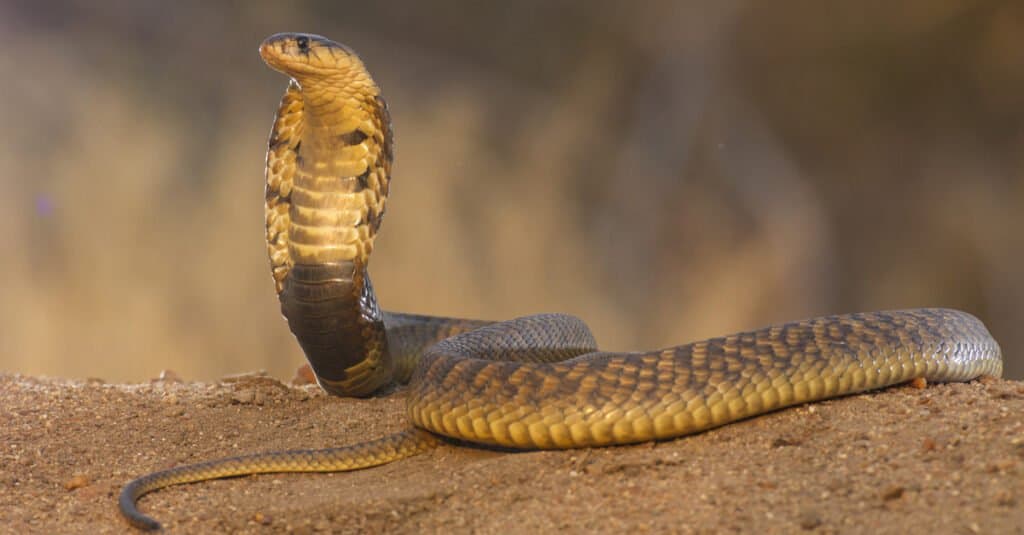
Stu Porter/Shutterstock.com
The next reptile fact on our list is mainly interesting due to the sheer number of species that exist! The class Reptilia is a massive one composed of over 10,000 unique species of lizards, snakes, crocodilians, turtles, and, of course, tuataras.
Lizards make up almost half of this group. Currently, almost 5,000 species of lizards exist, such as geckos, monitors, iguanas, agamids, skinks, and chameleons. Amphisbaenians, or worm lizards, are also sometimes grouped in with typical lizards and consist of more than 200 species.
Snakes make up another 3,500 or so, or almost a third of the entire group. From vipers to garter snakes and even the rare sea snakes and more, they’re a surprisingly diverse bunch!
Turtles make up a much smaller piece of the pie at around 360 different species. Turtles and tortoises are often collectively known as Testudines.
Crocodilians are an even tinier portion, with there currently being 27 unique species of alligators, caimans, crocodiles, and gharials.
Finally, when it comes to the lizard-like Rhynchocephalians, only a single species remains today: Sphenodon punctatus, the tuatara.
9. Not all reptiles are “cold-blooded.”
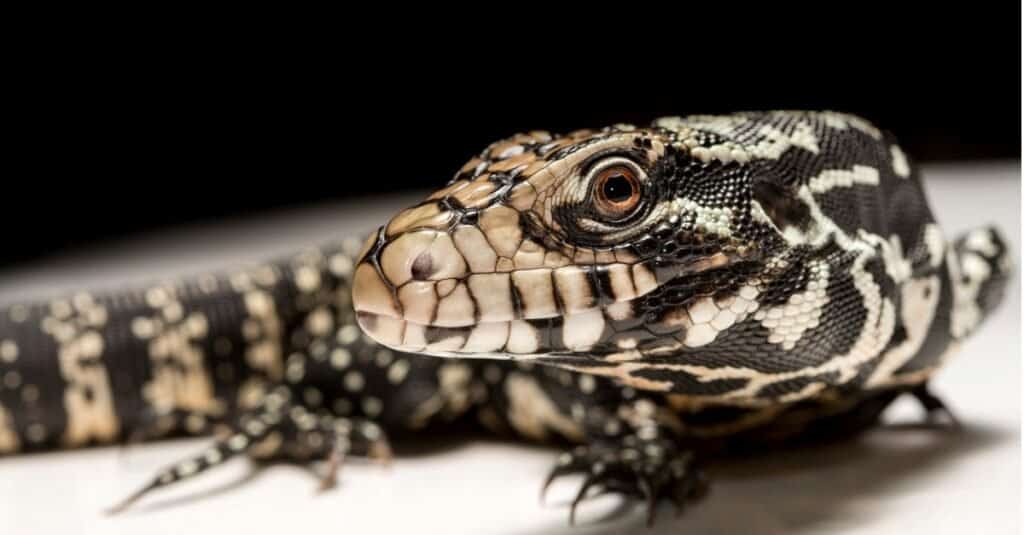
iStock.com/Rafael Cutó
When it comes to thermoregulation, or how an animal maintains its body temperature, we generally lump animals into one of two groups: endothermic and ectothermic. We typically refer to “cold-blooded” animals as ectothermic, while “warm-blooded” animals are endothermic.
To put it as concisely as possible, endothermic “warm-blooded” animals are able to maintain their internal body temperature on their own. Heat is given off as a sort of byproduct of the animal’s normal everyday biological processes like digestion and respiration.
Ectothermic or “cold-blooded” animals, on the other hand, must rely on their environment to stay warm or to cool off. Reptiles are almost exclusively ectothermic. They will employ behaviors like basking in the sun or burrowing in some cool sand to raise or lower their temperature when needed.
However, in recent years, studies have found that some tegu lizards are actually capable of temporary endothermy! During their mating season, Argentine black and white tegus can raise and lower their own body temperature by as much as 18 degrees. This unique ability makes them partially endothermic, or “warm-blooded!”
10. Reptiles eat their shed skin.

Jeff McGraw/Shutterstock.com
All reptiles shed their skin every so often as they grow. But that’s not the most amazing part of this particular reptile fact! Some reptiles are extra resourceful and will actually make a meal out of the ordeal. Many lizards, turtles, and snakes often eat their shedding skin off their bodies. While it looks pretty gross, there are a couple of important reasons why they do this!
First, by eating their shed skin, a reptile can eliminate any trace of their scent to make it harder for predators to locate them. Even in captivity, many reptiles will instinctively eat their shed skin.
Additionally, their shed skin can contain lots of vitamins and minerals to essentially provide a modest bonus meal! Even if your pet lizard is pampered and well-fed, they might not be able to resist the idea of an extra snack–despite it not looking very appetizing to us.
More from A-Z Animals
From fearsome snakes to gentle tortoises, reptiles are a diverse and fascinating group of animals that have existed for hundreds of millions of years! Learning about our planet’s scaly inhabitants is always a treat, so I’ve put together a list of 10 of my favorite reptile facts that always manage to raise a few eyebrows when I share them.
Read on to learn some of the weirdest, creepiest, coolest, and overall most amazing facts about snakes, lizards, tortoises, crocodilians, and more.
1. The earliest reptile species lived over 300 million years ago.

iStock.com/Denja1
Historically, there’s been a lot of debate over what the first “true” reptile was and exactly when it first emerged from the Earth’s oceans. There are a handful of ancient animals that have been suggested, from the more amphibious Westlothiana to the poorly-documented Casineria.
The one species that archaeologists and other experts can agree on as the very first undeniable reptile, though, is none other than Hylonomus lyelli. It lived roughly 312 million years ago during the Late Carboniferous period, a time when amphibians were gradually making their transition onto land. Taxonomically, it belongs to the Sauropsida clade of “mammal-like” reptiles with “lizard faces.”
Fortunately, we have a fairly extensive fossil record for Hylonomus lyelli. Critically, this means we have a good idea of what it looked like and how it lived. The typical Hylonomus lyelli individual was likely around 8 to 10 inches long when fully grown, and it actually closely resembled most modern lizards of roughly the same size. It was probably an insectivore and fed on small insects and other invertebrates.
2. Some reptiles (mostly lizards) have a “third eye.”

Martin Pelanek/Shutterstock.com
Most lizard species actually have a very tiny, primitive third eye–better known as a parietal eye–that can sense changes in light overhead. Interestingly, many amphibians and even some bony fishes also possess this bizarre yet helpful trait.
To be clear, this “eye” is nowhere near as advanced as the typical lizard’s other two far more sensitive and biologically advanced eyes. On most lizards, the parietal eye is barely larger than the head of a pin, and it lacks the sensitivity and detail to perceive defined images and movement. Instead, it uses its own unique method to pick up on subtle changes in light and shadows. In addition, it works with the pineal gland to regulate hormone production.
While this doesn’t seem terribly impressive at first, the reptilian third eye is surprisingly helpful for thermoregulation and evading predators. It usually sits beneath a thin, protective translucent scale atop the lizard’s head between its true eyes.
3. The oldest living reptile on Earth is Jonathan, a 190-year-old tortoise.

It’s no secret that tortoises have figured out the secret to living long, happy lives, but did you know that one of them is over 190 years old?
Incredibly, Jonathan the Seychelles giant tortoise hatched all the way back in 1832! Photographs of him exist from as far back as 1886, and in said photos, he was fully mature. This means he was already at least 50 years old in his oldest photo!
Jonathan has done a lot of traveling over the years, but today, he lives on a lavish, expansive plantation on the British island of Saint Helena. He doesn’t live there alone, though! By his side for more than 30 years is his companion, Frederica, another Seychelles giant tortoise with whom he spends much of his time eating, sleeping, and relaxing.
In more recent years, Jonathan has gone blind and lost much of his sense of smell. Other than that, he is remarkably healthy and active for his astonishingly old age!
4. One of the most ancient reptiles still alive today, the tuatara, is a “living fossil.”

One of the oldest and most perplexing reptiles still living today is the strange-looking and poorly understood tuatara. Although it looks a bit like a more primitive lizard, it is, in fact, part of its own distinct taxonomic order, Rhynchocephalia.
Notably, these ancient Rhynchocephalian reptiles evolved separately from lizards. They most likely originated around 250 million years ago during the Triassic period. Unfortunately, after the Jurassic period, most Rhynchocephalians went extinct around 60 million years ago.
Today, only one species of these unusual reptiles remains: Sphenodon penctatus, better known as the tuatara.
The typical modern tuatara is still vaguely lizard-like in appearance, with a greenish-brown body color and a crest of spines (similar to that of a green iguana’s) running from the base of the neck down to the tip of the tail. Its head is large and broad with fairly large, dark brown eyes. The tuatara’s feet are large and bulky, with four toes, each with a single thick, dense claw at the end.
Currently, the tuatara exists in fairly small numbers only in New Zealand and a few surrounding islands. It is protected by law and considered vulnerable on the IUCN Red List due to habitat loss and the introduction of predators like the Polynesian rat.
5. Tortoise and turtle shells are part of their skeletons and grow as they age.

Elena M. Tarasova/Shutterstock.com
That’s right–turtles’ shells aren’t at all like those of hermit crabs, so they can’t just swap them out as they please. Their shell is part of their body, so they can’t remove it. Thankfully, turtle shells are primarily made of bone, so they can simply grow along with a turtle as it ages.
Incredibly, the top, dome-shaped portion of their shell, the carapace, is actually made of modified rib bones! As those rib bones grow and spread out, they form lots of flattened sections. These sections, known as scutes, mold together and make up the carapace.
The outside of a turtle’s shell is covered in a layer of keratin. This is the same “stuff” that makes up our hair as well as many other animals’ claws and horns. The underside of the shell is the plastron.
And here’s a two-for-one reptile fact: it is also possible to determine the sex of many species of turtles just by the shape and positioning of their plastron scutes!
6. Some reptiles can regenerate their tails via a process known as autotomy.

Milan Zygmunt/Shutterstock.com
Autotomy is a unique defense mechanism that literally means “self-amputation.” While it sounds pretty brutal, many reptiles’ bodies have evolved to be able to sever and regenerate their own tails painlessly and surprisingly quickly! This particular type of autotomy is known as caudal autotomy.
Many species of lizards (as well as the aforementioned tuatara!) are capable of severing their own tails at will. This clever method of self-defense both creates a distraction for a looming predator and, amusingly, provides it with a meal as a sort of consolation prize. The severed tail will even twitch and move on its own for an hour or more due to muscle spasms!
What’s more, some lizards like leopard geckos can even regrow their tails multiple times. Depending on the species, it can take anywhere from 1 to 3 weeks to fully regrow a lost tail. This gives them an extremely valuable defense mechanism that they can reuse every once in a while!
7. There are three different types of reptile teeth.

Guillermo Guerao Serra/Shutterstock.com
Reptile dentition is a surprisingly complex topic, as there are three main types of reptile teeth: acrodont, pleurodont, and thecodont.
Acrodont teeth are most common amongst small lizards. They are the weakest and smallest of the three types and are fused to the sides of the jaw bones rather than firmly embedded within the jaw itself. Since they are only superficially attached to the lizard’s jaw, acrodont teeth break very easily. Fortunately, most reptiles with acrodont teeth regrow them over time.
Pleurodont teeth are more common in larger lizards like monitors and iguanas. However, some smaller lizards can also have them; sometimes, lizards like geckos will have a mixture of acrodont and pleurodont teeth. These teeth have a much stronger attachment to the jaw compared to acrodont teeth. Still, they aren’t actually embedded into the jaw itself. Thankfully, like acrodont teeth, they regrow continuously over time.
Finally, thecodont teeth are rare and primarily seen in crocodilians. Thecodont teeth are actually embedded within individual sockets in the jaw. This, as well as the fact that they can present in a variety of shapes and sizes, makes them extremely strong and sturdy. Interestingly, many snakes also have modified thecodont teeth.
8. Currently, there are over 10,000 distinct species of reptiles.

Stu Porter/Shutterstock.com
The next reptile fact on our list is mainly interesting due to the sheer number of species that exist! The class Reptilia is a massive one composed of over 10,000 unique species of lizards, snakes, crocodilians, turtles, and, of course, tuataras.
Lizards make up almost half of this group. Currently, almost 5,000 species of lizards exist, such as geckos, monitors, iguanas, agamids, skinks, and chameleons. Amphisbaenians, or worm lizards, are also sometimes grouped in with typical lizards and consist of more than 200 species.
Snakes make up another 3,500 or so, or almost a third of the entire group. From vipers to garter snakes and even the rare sea snakes and more, they’re a surprisingly diverse bunch!
Turtles make up a much smaller piece of the pie at around 360 different species. Turtles and tortoises are often collectively known as Testudines.
Crocodilians are an even tinier portion, with there currently being 27 unique species of alligators, caimans, crocodiles, and gharials.
Finally, when it comes to the lizard-like Rhynchocephalians, only a single species remains today: Sphenodon punctatus, the tuatara.
9. Not all reptiles are “cold-blooded.”

iStock.com/Rafael Cutó
When it comes to thermoregulation, or how an animal maintains its body temperature, we generally lump animals into one of two groups: endothermic and ectothermic. We typically refer to “cold-blooded” animals as ectothermic, while “warm-blooded” animals are endothermic.
To put it as concisely as possible, endothermic “warm-blooded” animals are able to maintain their internal body temperature on their own. Heat is given off as a sort of byproduct of the animal’s normal everyday biological processes like digestion and respiration.
Ectothermic or “cold-blooded” animals, on the other hand, must rely on their environment to stay warm or to cool off. Reptiles are almost exclusively ectothermic. They will employ behaviors like basking in the sun or burrowing in some cool sand to raise or lower their temperature when needed.
However, in recent years, studies have found that some tegu lizards are actually capable of temporary endothermy! During their mating season, Argentine black and white tegus can raise and lower their own body temperature by as much as 18 degrees. This unique ability makes them partially endothermic, or “warm-blooded!”
10. Reptiles eat their shed skin.

Jeff McGraw/Shutterstock.com
All reptiles shed their skin every so often as they grow. But that’s not the most amazing part of this particular reptile fact! Some reptiles are extra resourceful and will actually make a meal out of the ordeal. Many lizards, turtles, and snakes often eat their shedding skin off their bodies. While it looks pretty gross, there are a couple of important reasons why they do this!
First, by eating their shed skin, a reptile can eliminate any trace of their scent to make it harder for predators to locate them. Even in captivity, many reptiles will instinctively eat their shed skin.
Additionally, their shed skin can contain lots of vitamins and minerals to essentially provide a modest bonus meal! Even if your pet lizard is pampered and well-fed, they might not be able to resist the idea of an extra snack–despite it not looking very appetizing to us.




